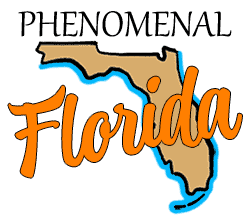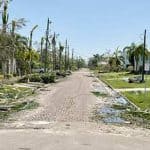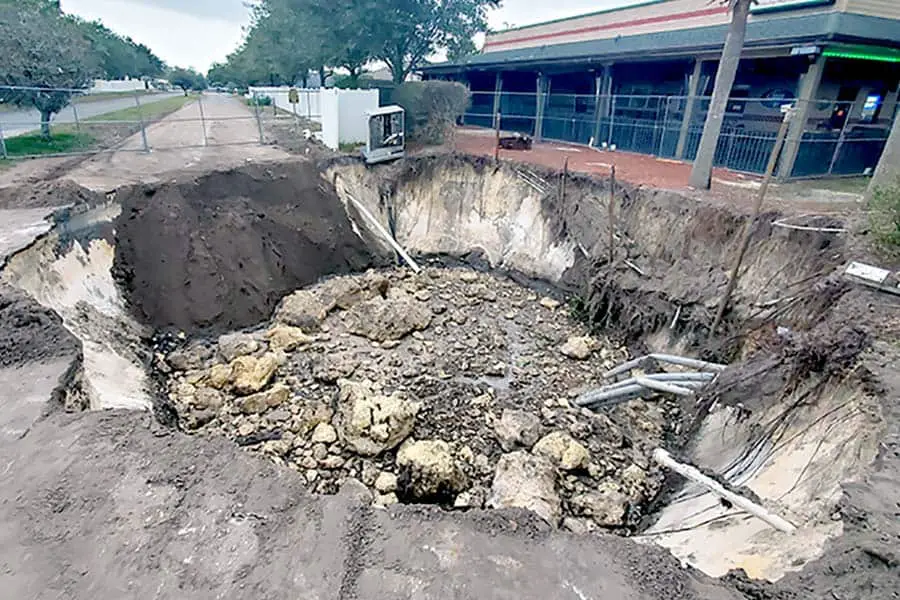
A sprawling, sun-soaked house with a green lawn, some palm trees, and maybe a pool in which to bask in Florida’s bright sunlight sounds like paradise. But haven’t some people lost homes in Florida to massive, unexpected sinkholes? So are sinkholes a problem in Florida?
Sinkholes are a common occurrence in Florida. Unfortunately, the state’s geology makes it prone to sinkholes. While many of Florida’s sinkholes are small and relatively harmless, others have been known to swallow lawnmowers, cars, houses, or even neighborhoods.
Why is Florida so prone to sinkholes? Do people die in sinkholes in Florida? What is sinkhole alley? As you continue reading, you will learn the answers to these questions and more.
A Deep Dive Into Florida Sink Holes
We’ve heard all about them and maybe have a vague idea about what they are, but what exactly is a sinkhole? According to the U.S. Geological Survey, a sinkhole is a depression in the ground with no external drainage. Instead, water drains downward out of the sinkhole, eroding the rock that underpins the surface layer.
This erosion of the underlying rock causes an underground cavern to form. When the cavern becomes big enough, it can no longer support the surface layer. The surface layer then collapses into the sinkhole, taking with it anything that happens to be resting on the surface. This collapse is often quite sudden and dramatic: one moment, the earth is there, and the next moment it’s gone.
The biggest sinkhole in recent memory occurred in Land O Lakes, Florida, and measured almost 260 feet across. This monster sinkhole caused seven homes to be condemned and required more than 135 truckloads of limestone to fill. More recently, a sinkhole about 20 feet across and 35 feet deep has been threatening residents of The Villages, a popular retirement community.
The Land O Lakes sinkhole was uncommonly large. Scientists believe that the average sinkhole in Florida is about 11.2 feet across. However, the depth of sinkholes varies widely: some are just a few feet in depth, but others can be startlingly deep. An infamous sinkhole in 2013 in Tampa was more than 20 feet deep and swallowed a man’s house with him in it – the man, unfortunately, perished.
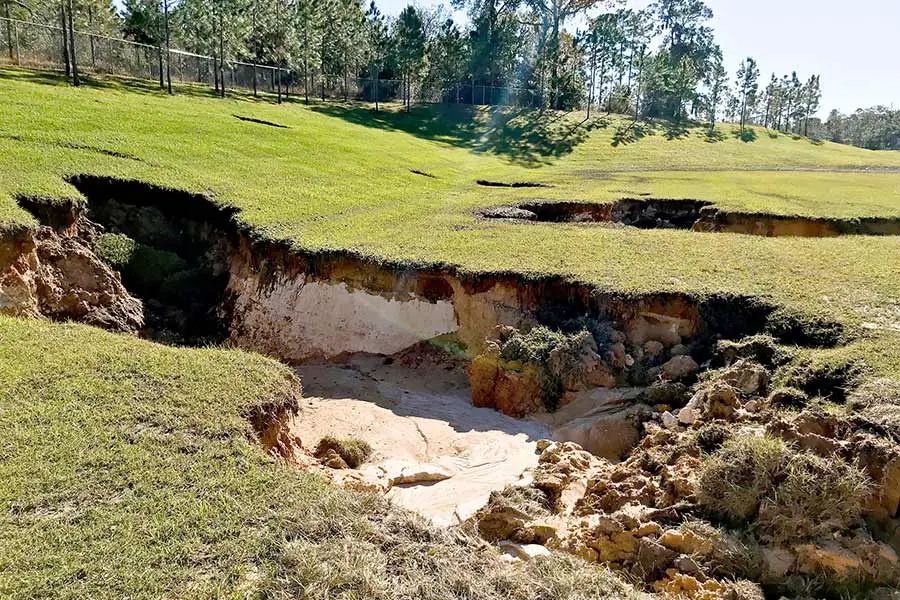
Sinkholes are a common occurrence in the Sunshine State, thanks to the unique geology of the Florida peninsula. Unfortunately, there is not a formal system for tracking how many sinkholes occur in a year in Florida, but BBC researchers analyzed homeowners insurance data and found about 6,500 claims a year for sinkholes in Florida.
Even accounting for a certain level of fraud or improper claims, it’s safe to say that sinkholes are an everyday occurrence in the state. Remember, however, that many of these sinkholes are minor: some may just be under walkways, in gardens, or near improperly plumbed drainage or pipe systems.
What would you find if you were to journey to the bottom of a sinkhole? For the most part, you’d find bedrock. Sinkholes are usually close to the surface and relatively small, sometimes just a few inches across. If you excavated these smaller holes, you’d likely find more groundcover and earth: the materials at the bottom will be denser than those on top.
Some sinkholes fill with water. For example, the Winter Park Sinkhole is now known as Lake Rose, in honor of one of the residents whose house was swallowed by the sinkhole.
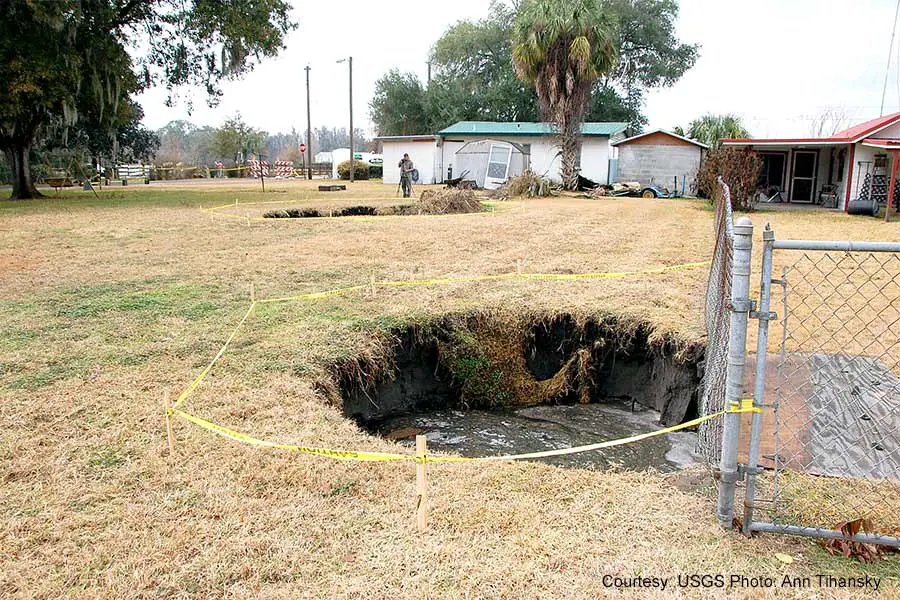
A sinkhole filled with water is called a cenote; technically, Lake Rose would now be considered a cenote. These formations are found not just in Florida but also in exotic locations; one of the most famous cenotes in the world is the Great Blue Hole of Belize.
Sinkholes in Florida are most prevalent during the early spring to the late summer. Some people even use the phrase Sinkhole Season to describe this time of year! There are three main reasons why sinkholes tend to blossom at this time of year.
First, spring is rainy. The frequent storms add rainwater to the dry earth, which becomes heavier when wet. As the water drains, it erodes limestone beneath the soil. This combination of erosion and increased mass causes the sinkhole to collapse.
Second, spring is a busy season for Florida’s farmers. During cool weather, farmers spray their crops to create ice “shells” around crops, which ironically prevents them from the cold outside of the ice. However, this requires a lot of water: spray operations can deplete aquifers overnight, destabilizing soil and leading to collapse.
Finally, spring begets construction. Unfortunately, construction often has serious effects on how water flows throughout a given area. These changes in the hydrology of an area can cause damage to the surface or to the areas around the construction site, flooding, and erosion, all of which increase the risk of a sinkhole opening up.
Other Posts of Interest
- Is Lake Okeechobee Saltwater Or Freshwater?
- Does Florida Have The Longest Coastline?
- Why Is The Sunshine Skyway Bridge So Tall?
- Why Does Florida Have So Many Canals?
Phenomenal Florida Fun Fact: The biggest sinkhole in Florida is believed to be the infamous Winter Park Sinkhole, which opened in 1981 and swallowed a home, six Porsches, and the auto shop that was working on them, a swimming pool, and several trees. The hole measured 320 feet across and 90 feet deep.
Why is Florida Prone to Sinkholes?
Florida is especially susceptible to sinkholes because of the state’s unique geology. Florida is mainly made of limestone, which dissolves pretty easily in rainwater — especially since rainwater tends to acidify as it drains through the terrain.
This process results in a type of terrain known as karst, which is honeycombed with cavities. When these cavities become large enough, they can collapse.
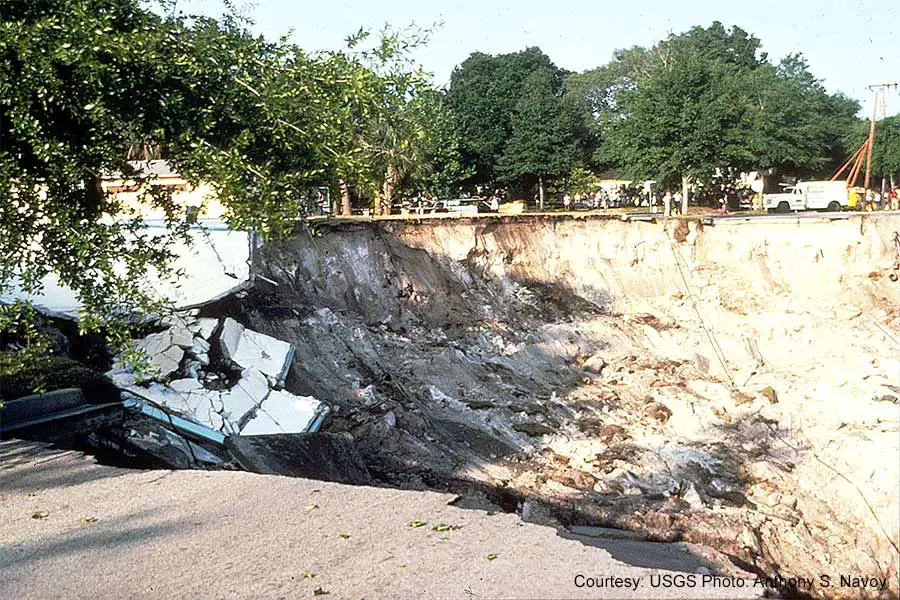
Where is Sinkhole Alley?
While all of Florida is prone to sinkholes, the area encompassing Hillsborough, Pasco, and Hernando counties is commonly known as Sinkhole Alley. Nearby places like Marion County and Polk County have also been known to experience a significant number of sinkholes.
While some of them can cause damage to homes or property, many end up being relatively small. As a result, a number of companies exist in Central Florida for the purpose of finding, filling, and mitigating sinkholes.
How Many Deaths From Sinkholes in Florida?
While sinkholes are not unusual in Florida, deaths from sinkholes are much less common. The unfortunate death of a man named Jeff Bush in 2013 is the most recent known sinkhole fatality in Florida. Mr. Bush was asleep in his bedroom when a 20-foot-deep sinkhole opened beneath his home. Unfortunately, he died in the ensuing collapse.
However, such deaths are very rare. It’s estimated that there have only been four sinkhole deaths in recorded history in Florida.
There are often warning signs that a sinkhole is opening, and most people in Florida have enough awareness about the danger to keep their distance from depressions in the ground, large cracks, and other disturbances that are suspicious for sinkholes.
Are Sinkholes in Florida Increasing?
During sinkhole season, incidents are pretty common and can sometimes generate a large amount of publicity.
The incidence of sinkholes can also increase dramatically after a large storm, mainly because the excess water that is dumped in from a hurricane or tropical storm can exacerbate existing problems in the ground and make a sinkhole more likely to open up.
Despite occasional surges in the number of sinkholes during the rainy season or after storms, the overall rate of sinkholes in Florida is very stable.
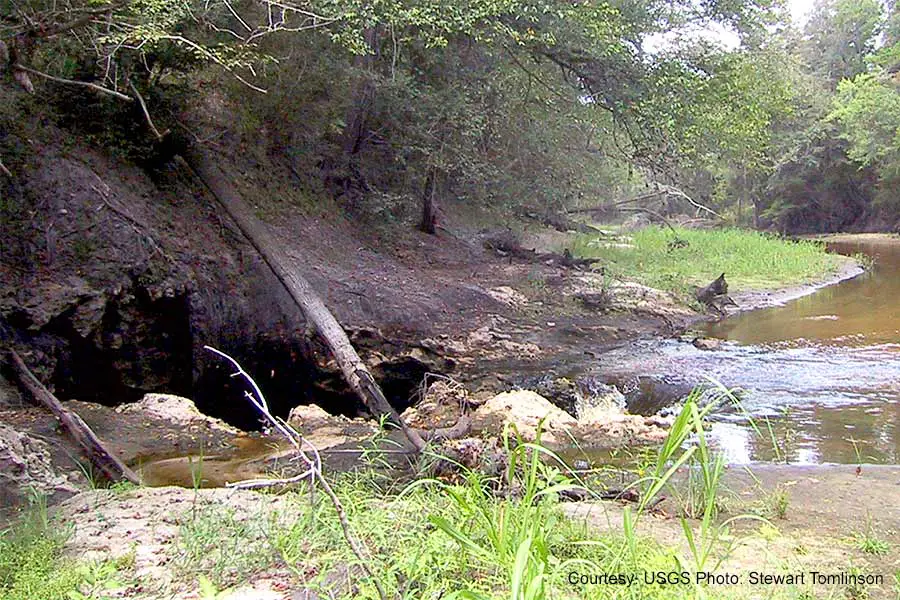
What Part of Florida has the Least Sinkholes?
Sinkholes can be found in any part of the Sunshine State. However, the incidence of sinkholes is generally lower on the state’s east coast.
The area near St. Augustine tends to report fewer sinkholes than other regions. South Florida, including Miami Dade and Broward counties, also tends to suffer from fewer sinkholes than the rest of the state. However, the entirety of Florida is at risk for sinkholes.
I’ve Got A Sinking Feeling
Florida is a beautiful place, but for many people, the prospect of being sucked into a sinkhole becomes a source of worry. However, while sinkholes are common in the state, most of them aren’t a source of a lot of anxiety. For your average Floridian, sinkholes are only a minor concern.
Part of that relaxed attitude about sinkholes comes from familiarity. For example, a sinkhole might open up on a nearby road, only to be excavated and filled by the public works department in hours.
Your sprinkler system might malfunction and excavate a sinkhole beneath your walkway, which you can repair quickly. The kind of sinkhole that eats a resort or a house is very uncommon. You’re more likely to be struck by lightning than to end up in a sinkhole.
If you’re buying property and you’re concerned, you can hire geologists and experts to assess your property. In the unlikely event that you have a significant sinkhole on your property, there are plenty of construction companies with expertise in sinkhole repair.
So while we do have sinkholes here in the Sunshine State, don’t let them sink your spirits. The only sinking you need to worry about here is the sun sinking over the beach!
